One of the places to see in East Kalimantan is Kutai National Park with wild orangutans tour and jungle trekking activities. This 200 000 ha rainforest gives shelter to wildlife of Borneo Island, such as orangutans, gibbons, hornbills or proboscis monkeys. Apart from tropical rainforest, it’s also a place to see unique caves and mangrove forest as well as wetlands and lakes. However, from all the above, orangutans conservations center called PREVAB is the most visited part of the national park. And this is where I got to observe lovely family of Borneo wild orangutans, got eaten by fire ants and saw an enormous tarantula. Wild orangutans trekking tours in Borneo are one of the most desired attractions, however are there everywhere ethical? Let me tell you about my jungle experience on Kutai National Park tour.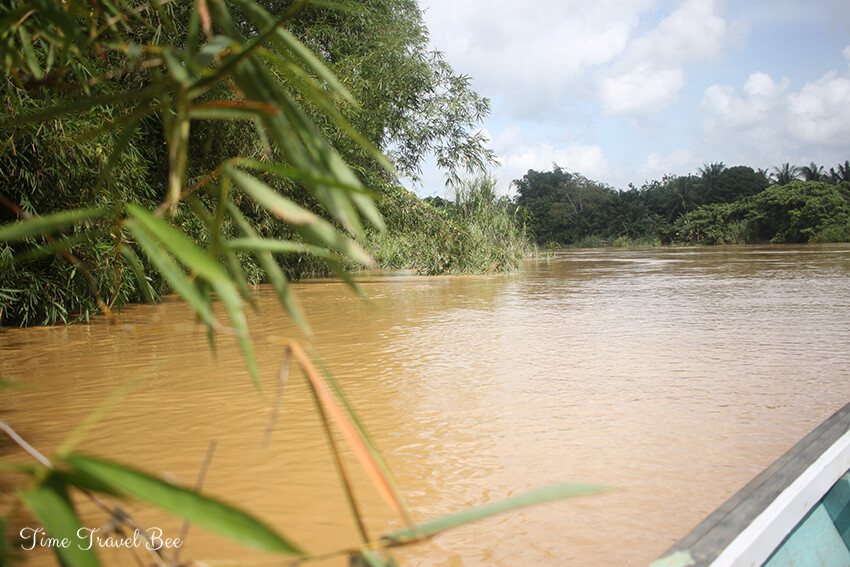
Borneo wild orangutans trekking
According to the scientists, orangutan share 97 % of DNA with human. While on the way of evolution, humans started to seek for food on the land and developed their standing posture, orangutans stayed on the trees. With huge arms and legs they are prepared for living all their lives on the trees. The word orangutan comes from Malay language and means person (orang) forest (utan), it’s basically translated to “man of the forest.”
Orangutans are on the extinction list due to human “development”: massive deforestation, settlements, mines, plantations and large forest fires. They exist only in two places in the world: Sumatra Island and Borneo. I already went for orangutan trekking in Bukit Lawang, Sumatra, which was an amazing experience. Therefore, I went to seek wildlife of the rainforest again, while visiting Malaysian part of Borneo. I saw Borneo’s wild orangutans on Kinabatangan River Cruise and in Danum Valley National Reserve, both in Sabah, Malaysia. I decided to stop in East Kalimantan on Indonesian part of Borneo, to see Kutai National Park orangutans and stay overnight in the buzzing rainforest.
Guide to Kutai National Park
There is not much information about East Kalimantan and wild orangutans tours on the Internet. Therefore, I am doing my best to describe my experiences with details and already wrote a guide to Derawan Islands and soon coming an article about visiting Dayak tribe in East Kalimantan. I am hoping this guide to Kutai National Park will be also a helpful bit for your trip.
Basically, there are two options to visit Kutai National Park in East Kalimantan. First one is to do all by yourself, bring your food and stay at the Camp Kakap. Second is to pay agency to arrange everything for you, together with picking up, food and fees. I will explain both ways with details and indicate Kutai National Park prices. As I am trying to improve as responsible traveler and inspire others for positive changes, I will also mention how is ecotourism doing in East Kalimantan, but also some practical tips and how to get to Kutai National Park.
DIY guide to Kutai National Park
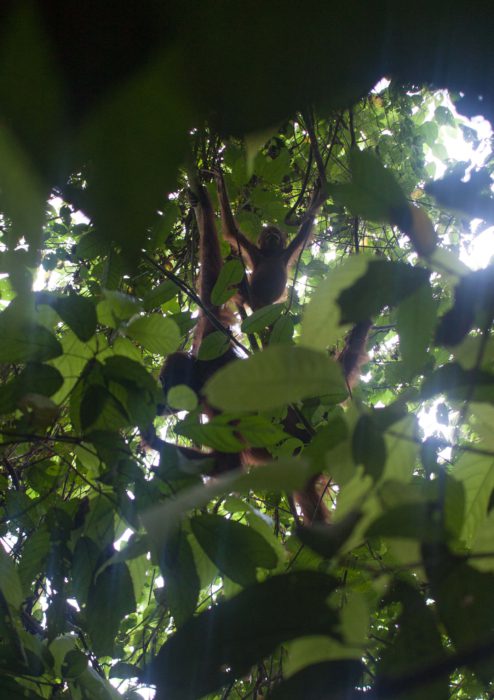 Visiting Kutai National Park for wild orangutans trekking should begin with checking the available slots at the Camp Kakap. You can ask in the office of Kutai National Park in Sangatta city. The address is: Seksi Pengelolaan Taman National, Wilayah 1 Sangatta, Jl. Assadiyah, Sangatta. Even better trying to reach the officer in PREVAB Kutai National Park, Mr. Saragih by phone or Whatsapp: +62 811581056. Number still actual in 2020. If you carry your own tent or hammock, you can skip the step above and head directly to the Camp Kakap. When the rooms are full, you can camp around or sleep on the wooden terrace.
Visiting Kutai National Park for wild orangutans trekking should begin with checking the available slots at the Camp Kakap. You can ask in the office of Kutai National Park in Sangatta city. The address is: Seksi Pengelolaan Taman National, Wilayah 1 Sangatta, Jl. Assadiyah, Sangatta. Even better trying to reach the officer in PREVAB Kutai National Park, Mr. Saragih by phone or Whatsapp: +62 811581056. Number still actual in 2020. If you carry your own tent or hammock, you can skip the step above and head directly to the Camp Kakap. When the rooms are full, you can camp around or sleep on the wooden terrace.
Camp Kakap is both a visitors center and a research station. There are 2 rooms there (large enough for 4 people each) equipped with old mattresses and mosquito nets. All very simple, no luxury. I was the only woman there, so they gave me a room just for myself. In the second room there were Indonesian students of forestry department. There is a kitchen with cooking gear, gas, fridge, as well as running water. Be sure to bring your own food and water to prepare meals.
At the Camp Kakap, you will meet rangers who will offer you guided tours for wild orangutans watching as well as night jungle trekking. The rangers will tell you that you must always enter the jungle with the guide, because people get lost and loose GPS signal. Despite the fact that PREVAB is not a big area, there is a map and marks on the paths, they will insist. Nothing to do about that, this is their job and they want your money as well as your safety.
Jungle trekking in Kutai National Park includes 2 walks during the day: from 7 to 9 and from 2 to 5 pm. In between this hours orangutans are having a nap, so it’s very hard to spot them. Additionally, there is a night walk to seek tarantula and other nocual insects. No matter how many days you want to stay in PREVAB Kutai National Park, these are the activities to repeat all over until you are satisfied with your jungle experience and wild orangutans trekking.
If you are looking for tips on what to pack for a jungle trekking and how to prepare, I wrote more here, after Danum Valley tour.
How to get to Kutai National Park?
The closest airport will be in Balikpapan – the capital of East Kalimantan. Then you can use public buses or shared taxis to Bontang (the closest city) or directly to Sangatta, where Kutai National Park tours start. It takes around 7 hours by car, a bit longer by bus. I came by land from Malaysian part of Borneo, and I continued by ferry to the neighbour island – Sulawesi. It was pain in the ass with land and sea transportation, but I wanted to limit my carbon footprint and avoid planes as much as possible.
From Sangatta, take an angkot heading North and ask the driver to drop you in Kabo Jaya village. From there ask for a boat to take you to PREVAB or more precisely Camp Kakap. The longtail boat will take around 10 min. to reach Camp Kakap. You will pass through fields and devastated forest to finally arrive to the dock of PREVAB. It’s very near to the villages, and you can still have the 4G signal and hear the sound of the mosque as well as see the palm oil plantations on the other side of the river.
Kutai National Park tour itinerary with agency
If you choose to go for wild orangutans tour with agency and don’t worry about a thing, here is the usual itinerary for 3D2N stay.
Day 1: HOTEL – SANGATA – PREVAB
After breakfast, transfer from Balikpapan to Sangatta for about 7 hours with lunch included. Boarding to the longboat and transfer to the camp. Afternoon wild orangutans trekking. Dinner.
Day 2:
Wake up early morning at 05:30, then breakfast at 06:00. Afterwards, start your jungle trek to search more wild orangutans and gibbons. Lunch at the camp and another jungle trekking at 3:00pm. After dinner, walk again into the forest to see insects, sleeping birds and Tarantula.
Day 3: BASE CAMP – KABO – SANGATA- BALIKPAPAN
Morning after breakfast, check out from the Base Camp, then boat down the river to Kabo Village. Transfer to Balikpapan and straight to the airport or hotel, if the plane is the next day.
I contacted Rimba Borneo Kalimantan, tour agency which took care of my transportation and delicious meals. Thank you for help Mr. Rusdy!
Kutai National Park orangutans
Quickly after my arrival to PREVAB in Kutai National Park, the ranger said he found orangutans family eating near the Camp Kakap. There was mother with a small baby, older brother and father. I could watch them for few hours and couldn’t be bored of observing these amazing creatures. The older orangutans didn’t care about human appearance as they are used to it. However, the baby was giving the show of swinging and jumping seeing “other monkeys” – us, staring at him. Before the sunset they made their nests high above us and went to sleep. Orangutans make new sleeping nest every single day. I was so glad to witness all these!
The next morning we went for another wild orangutans trekking and we found the same family at the same place as the day before. There was no father, though. Male orangutans live their life alone, travel from one place to another and seek females. We saw the baby playing again and swinging on the trees, mother finding new leaves and brunches to eat and older brother staying in a close distance. Kutai National Park tour was a memorable experience and surely excellent opportunity to watch wild orangutans of Borneo.

My lens has absolutely no zoom, so you can see that the orangutans were pretty close.
Tarantula trekking in Kutai National Park
In the evening we went for the night trek to seek nocual animals and observe sleeping birds. This is when I was eaten by the fire ants which were thousands. It really hurts. I saw the whole army of the fire ants eating a worm alife! Welcome to the jungle! We encountered plenty of weird shape insects and night butterflies. We found a few birds sleeping on the trees. They make their body like a puffy ball which protects them from the cold like a blanket. So cute!
Yet, the star of the evening has not arrived. Miss giant tarantula was standing near the hole and looking for victims. I knew they are the biggest spiders in the world, but I didn’t expect they are so giant! The guide said that I can come up close to take a photo but I was trilled. He told me that I am lucky to see the largest that a tarantula can get.
A tarantula makes a hole in the ground or uses holes of the trees to live in. They use the hole like a trap door for bugs and grasshoppers. Staying in the hole during the day, tarantulas come out to hunt at night.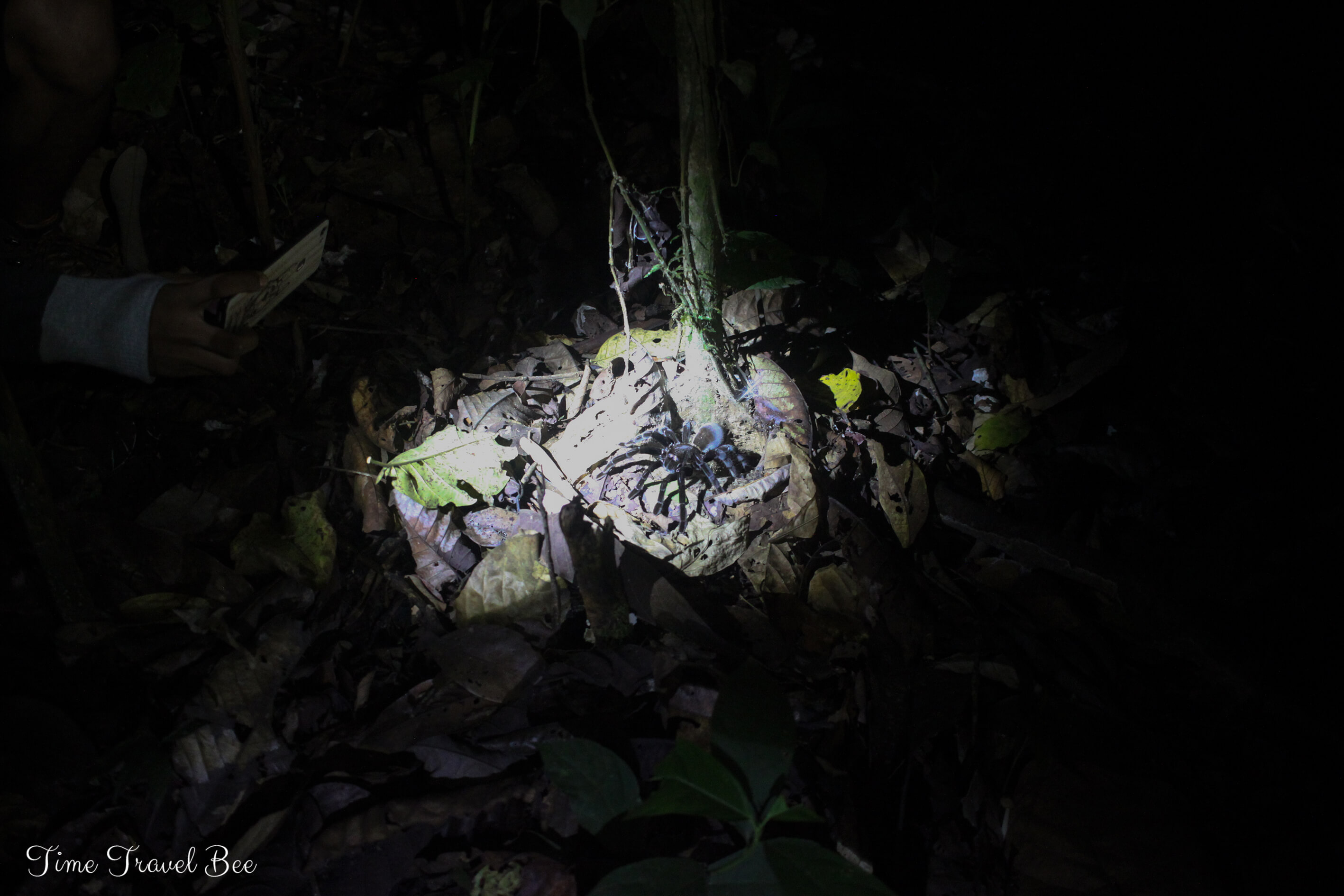
Kutai National Park prices
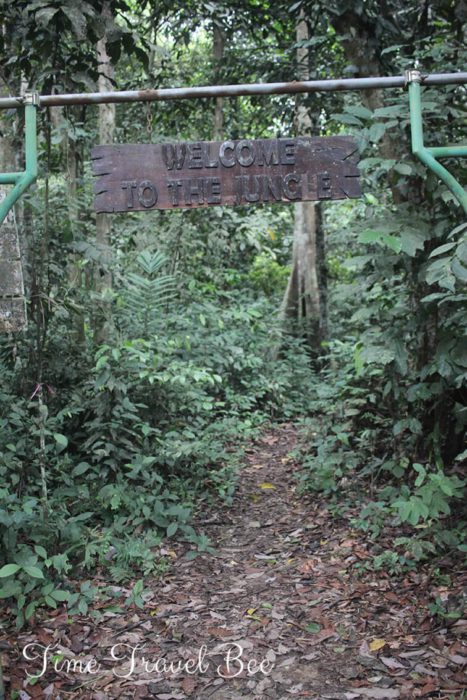 Here I come with all the costs you will have to pay for Kutai National Park tour. Please note that prices are flexible and the officers may charge you as they like. Be sure to discuss all details before the trip to avoid misunderstandings. Remember you are not a human, but a walking wallet (just joking, but sometimes I felt like that in Indonesia).
Here I come with all the costs you will have to pay for Kutai National Park tour. Please note that prices are flexible and the officers may charge you as they like. Be sure to discuss all details before the trip to avoid misunderstandings. Remember you are not a human, but a walking wallet (just joking, but sometimes I felt like that in Indonesia).
You should expect to pay:
– if you are coming from the south, public transportation from Balikpapan should cost up to 100 000 to reach Sangatta;
– 20 000 Rp for an angkot from Sangatta to Kabo Jaya, taxi 70 000;
– 150 000 Rp for a longtail boat (one way);
– Food and water – bring all by yourself from Sangatta;
– 150 000Rp/day for Kutai National Park entrance fee during weekdays and 225 000 on the weekend;
– 150 000Rp/person/night at the Camp Kakap;
– 200 000Rp per 2h guided walk / 100’000 per person or 500 000 for hiring the guide for the whole day. This means that you will pay 300 000 for the whole day including 3 jungle trekkings, if you are traveling alone. The price may vary from guide to another and there is a lot of playing around it so be careful.
Roughly, for 3D2N stay at Kutai National Park you need to spend around 1,5 – 2 million rupiah per person. Price for the same tour for locals would be less then 1 million rupiah while minimum wage for East Kalimantan province is about 2,5 millions rupiah. Just saying. It will be a bit cheaper if you are two or more people and share some costs. Bule “whities” have a lot of money, right?
The same tour done with agency and all included, additionally covers transfer from Balikpapan and back and 1 night in the hotel will costs around 6 million up to even 14 million rupiah per person depending of the agency.
Responsible tourism in KNP
I have to admit that KNP doesn’t have good management and the workers seem to care more about earning money from visitors and researchers than anything else. It really pisses me off to pay for something useless, and feeling like being a part of this corrupted society. Being on Kutai National Park tour I felt everyone is relaxed about any rules, as in the whole Indonesia. While relaxing is nice on the beach, considering the importance of wildlife left on Borneo, environment protection should just work better. Responsible tourism in Kutai National Park is an unknown term and ecotourism is seen as tourism close to nature.
The place I stayed in, PREVAB, had few Indonesian students of forestry department at that time. They literally did nothing apart from staring at their mobile phones. Near the camp there was a bunch of trash and lots of beer cans, so I assume there is no waste management in Kutai National Park at all. Be conscious that the waste you will create will end up in the jungle or be burnt. Therefore, try to throw nothing to the rubish, it’s better that you will bring it with you when going back to the city. Same for the toilet, as there is no septic tanks, all goes to the soil. Remember to not throw toilet paper and hygienic products and use organic toiletries to don’t harm nature. More tips here, on how to limit plastic waste when traveling.
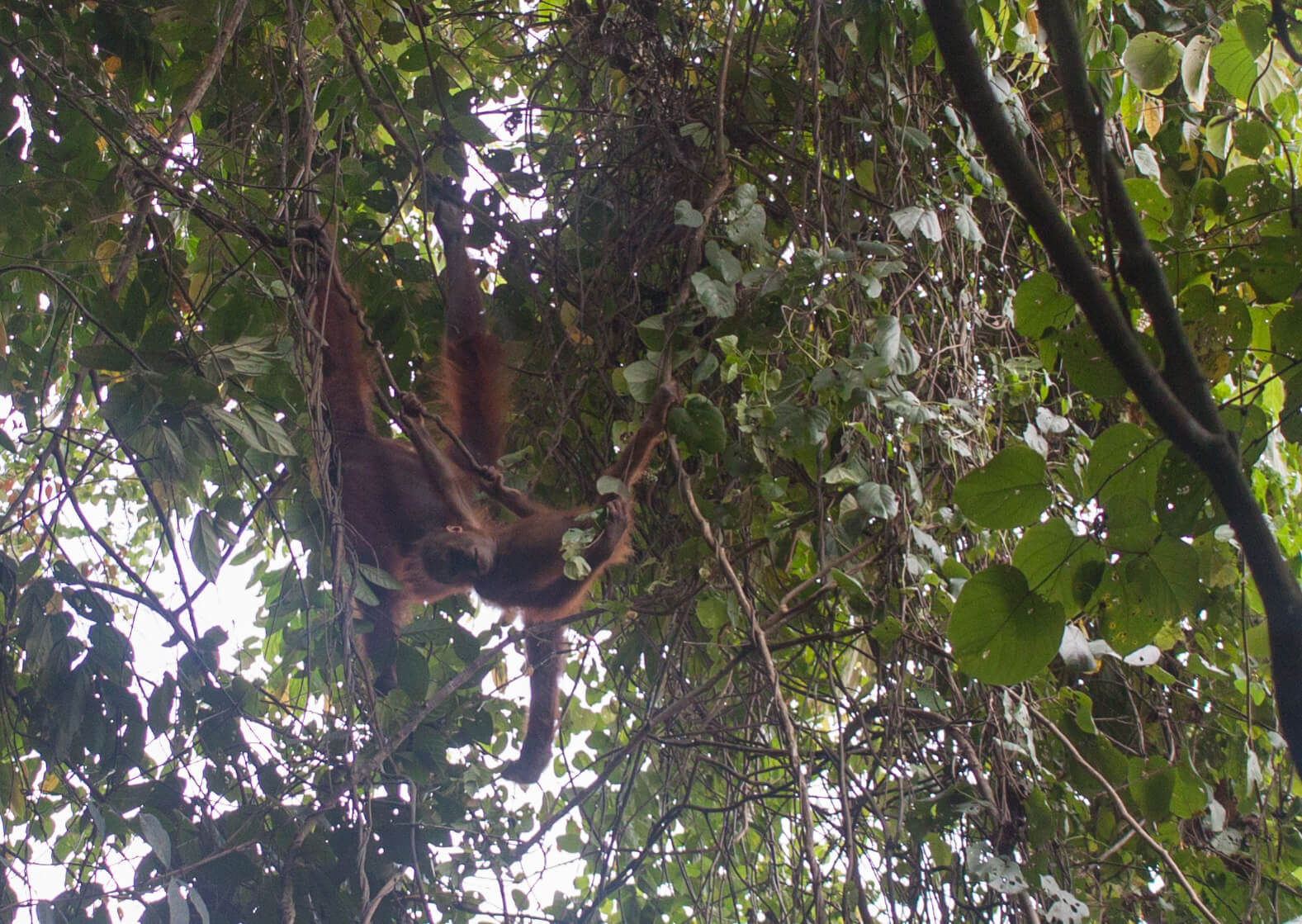
Is Kutai National Park tour ethical?
 I seriously doubt any money visitors leave in Kutai National Park goes for preservation of the rainforest. It’s a profit for rangers. I understand that this is their job and they should receive a salary, but seeing how little they do to protect nature and how much money they suck from tourists, I wasn’t happy to support that. With this policy and treating tourists like an ATM, Kutai National Park gets fewer and fewer visitors. I was the only tourist there.
I seriously doubt any money visitors leave in Kutai National Park goes for preservation of the rainforest. It’s a profit for rangers. I understand that this is their job and they should receive a salary, but seeing how little they do to protect nature and how much money they suck from tourists, I wasn’t happy to support that. With this policy and treating tourists like an ATM, Kutai National Park gets fewer and fewer visitors. I was the only tourist there.
At the same time, there is a orangutans conservation project constantly run by foreign researchers. They have monitored orangutans behaviors since a decade, also trying to report illegal activities in KNP. They basically sponsor this place, otherwise it probably would be a palm oil plantation already. However, I sincerely doubt that money you would leave for the Indonesian authorities of the national park or donate through any of Indonesian websites will do any good, knowing how corrupted is the country and how things work there. If you have been to Indonesia, you most likely know what I mean. Of course, I would like to be wrong here and if you know any trustable NGOs, do share in comments.
After visiting PREVAB, I didn’t feel like leaving my money in any other parts of KNP and left the area. I don’t think I would ever want to come back. I also got suspicious on going for any other wild orangutans tours, as I am not sure if they are ethical.
It’s easy to spot orangutans and other wildlife in Kutai National Park. Why? Because the primary forest is gone due to the fires and illegal loggers. That’s why the intact area with lots of food for wild orangutans is very small, and many animals tend to stay there. I was happy to spot orangutans so easily and close to the camp, but when I learnt why it was so easy, I was depressed. Farming, palm oil plantation, villages, mining – it all soaks the leftovers of the rainforest of Borneo. When even nature left in so called “National Parks” is not well protected, the future does not seem to show any optimistic side. Sorry to say all that, but after my trip around Borneo Island I see, with a broken heart and tears in my eyes, that there is no hope for the rainforest of Borneo.
How can I help orangutans?
I would normally tell you to support ecotourism and local initiatives when traveling, but in Indonesia you really need to be careful to choose what you support and don’t be a victim of greenwashing. Most of the people are not environmentally conscious and not educated on how to protect nature. If you want to donate or adopt virtual orangutan, I would suggest rather foreign organisations, which tend to work better. However, I am not able to advice one for you, as I don’t have knowledge on which one is trustable. Be careful with choosing wild orangutans trekking on Borneo, as this will not always be good for the animals.
If ecotourism doesn’t work in the national park and local authorities are not trustable to support them or give a donation, then how can I help wild orangutans? Well, the most important is to stop buying products which include the palm oil which is main reason for deforestation of rainforest. Destruction of nearly 40% of the Borneo’s rainforest was to plant the palm oil plantations. Palm oil is the most widely used vegetable oil in the world. An ingredient in cosmetics we use every day as well as food such as margarine, chocolate and nearly all the commercial sweats. If you want to give your part, please check the labels of the products you buy and put back to the shelf those who consist of palm oil.
The Bee is a nature lover and tea addict. Loves the idea of slow life and responsible traveling, constantly trying to improve to bee more eco-friendly. Appreciates old cultures and traditions, loves to immerse with locals, listen to ethnic music as well as taste regional food and drinks. Her favorite spots while traveling are family houses and street markets.



I am glad to have come across such an honest feedback on a place that takes care of nature’s resources! I feel that corona lockdown is teaching us one big lesson that we shouldn’t be blind towards nature while marching on the path of development. We need to take care of animals and plants and Australian bushfires are a grim reminder of that. Coming to the aesthetics of your blog post, I like the font on subheadings but there is overlap if the heading extends on the second line so maybe you can increase vertical spacing while inputting the subheading. Overall, a wonderful read!
I have never heard about Kutai national park and trekking in National Park sounds amazing. Glad to know you could see Orangutans with family and giant tarantula at night. This looks quite adventurous at night! Glad to know about ecotourism efforts by tourism boards and knowing about not supporting Palm oil Products to help conservation of Orangutus. Loved reading about offbeat destination of Malasiya.
Borneo has evaded me for a while. Plans are made but never completed. And for me, it is largely the Orangutans that attract me. This is a good guide to where to go for them. And the bonus, is the night hike. I am not a big fan of creepy crawlies but would not mind spotting a few while I am here. Thanks for all the tips associated with the park.
This would be such a cool experience! I have heard about Silverback Gorilla treks but this one sounds equally interesting. IT is also a great way to preserve the endangered Orangutans by making the visitors aware about them.
Visiting National Parks like this (and other animal sanctuaries) is what I prefer than a zoo. Seeing animals like the orangutan in its natural territory is an amazing experience, and they should stay that way. We need more organizations that help to protect and conserve wildlife.
That is a wonderfully written well compiled up post on Kutai National Park. We too would love to see Orangutans 🦧 here some day. Thanks for sharing so many insights and the interesting facts in this post. We never knew they build their new nest every night. Quite interesting.
Borneo is definitely on the list. I knew only park in Indonesia for a similar experiences. This just makes me desire more to visit Borneo. Love those little (not so) monkeys.
What a neat experience getting up close and personal with this unique creature! I honestly did not know where orangutans were native to until now. So cool that you can see them will hiking the National Park. Can’t wait to do the same!
I haven’t been to Malaysia yet and had no idea about trekking in Kutai National Park. I’ve only seen Orangutans in some of the zoos in the US but I bet watching them in their natural habitat would be a delightful experience in itself!
Kutai National Park is in Indonesia and yes, watching them in natural environment is totally different experience than any zoo can provide.